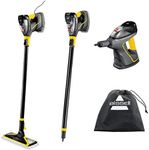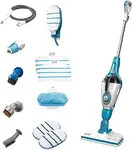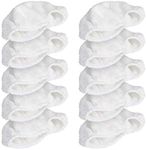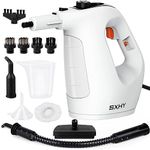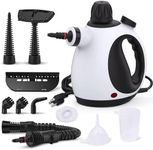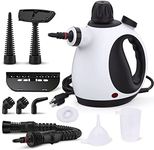Buying Guide for the Best Handheld Steam Cleaners
Handheld steam cleaners are compact devices designed to clean and sanitize surfaces using the power of hot steam. They are popular for their portability and ability to tackle tough grime without the need for harsh chemicals. When choosing a handheld steam cleaner, it's important to consider how and where you plan to use it, as different models offer varying features and performance levels. Understanding the key specifications will help you select a cleaner that matches your cleaning needs and lifestyle.Water Tank CapacityWater tank capacity refers to how much water the steam cleaner can hold at one time. This is important because it determines how long you can use the cleaner before needing to refill it. Smaller tanks (around 200-250 ml) make the device lighter and easier to handle, but require more frequent refills, which is fine for quick spot cleaning or small areas. Larger tanks (300-400 ml or more) allow for longer cleaning sessions, making them better for bigger jobs or multiple surfaces. If you plan to use your steam cleaner for extended periods or larger spaces, a bigger tank will be more convenient, while a smaller tank is suitable for quick, light tasks.
Steam PressureSteam pressure indicates how forcefully the steam is released from the cleaner, usually measured in bars or psi. Higher pressure means the steam can penetrate deeper into surfaces and remove tougher dirt and grime. Low-pressure models (around 2-2.5 bars) are suitable for light cleaning tasks like fresh spills or delicate surfaces. Medium pressure (2.5-3.5 bars) offers a balance for everyday cleaning, while high-pressure models (above 3.5 bars) are best for stubborn stains or heavy-duty cleaning. Choose a pressure level based on the types of messes you expect to tackle most often.
Heat-Up TimeHeat-up time is how long the device takes to turn water into steam and be ready for use. Shorter heat-up times (under 3 minutes) are convenient if you want to clean quickly or on the go, while longer times (3-5 minutes or more) may be acceptable if you don’t mind waiting. If you value speed and efficiency, look for a model with a fast heat-up time, especially if you plan to use it for quick cleanups.
Steam DurationSteam duration tells you how long the cleaner can produce steam on a single tank of water. Short durations (8-10 minutes) are fine for spot cleaning or small jobs, while longer durations (15-20 minutes or more) are better for cleaning larger areas without interruption. If you often clean bigger spaces or want to avoid frequent refilling, opt for a model with a longer steam duration.
Weight and ErgonomicsWeight and ergonomics refer to how heavy the steam cleaner is and how comfortable it is to hold and use. Lighter models are easier to maneuver, especially for extended periods or for people with limited strength. Ergonomic handles and well-balanced designs reduce hand fatigue and make cleaning more comfortable. If you plan to use the cleaner for longer sessions or have mobility concerns, prioritize a lightweight and ergonomic model.
Attachments and AccessoriesAttachments and accessories are the extra tools that come with the steam cleaner, such as brushes, nozzles, and scrapers. These expand the cleaner’s versatility, allowing you to tackle different surfaces like grout, upholstery, windows, or tight corners. More attachments mean more flexibility, but also more to store and keep track of. Consider what surfaces and types of messes you’ll be cleaning most often, and choose a model with the right set of accessories for your needs.
Safety FeaturesSafety features include things like child locks, pressure release valves, and indicator lights. These are important for preventing accidental burns or misuse, especially if you have children or pets at home. If safety is a top concern, look for models with clear safety mechanisms and easy-to-understand controls.
